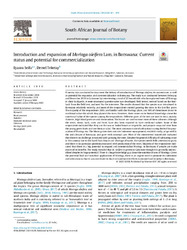| dc.description.abstract | A survey was conducted to document the history of introduction of Moringa oleifera, its current uses as well as potential for expansion and commercialization in Botswana. The study was conducted between February and December 2018 in Gaborone by interviewing a total of 20 households who have planted trees of Moringa in their backyards. A semi-structured questionnaire was developed, field tested, revised based on the feedback from the field test, and used for the interview. The results showed that the species was introduced to Botswana relatively recently, and most of the respondents started growing the trees in the last five years. The majority of the respondents (80%) are familiar with the Moringa plant, and 90% of them know about its medicinal values for which they planted the trees. However, there seems to be limited knowledge about the nutritional value of the species among the respondents. Different parts of the tree are used to treat, mainly, diabetes, high blood pressure and rheumatism. The leaves are used to treat most of these ailments although the seeds, stems, bark, roots and fruits have also been reported to have medicinal values. Some of the respondents indicated that they use the raw or boiled leaves as vegetable, and prepare soup and stew from the young green fruits and use them as salad. The most common mode of utilization is using the leaf for preparation of Moringa tea. The Moringa tree does not need intensive management, establish easily, adapt well to the arid climate of Botswana and grow with minimal care. Most of the interviewed households indicated that there is no challenge associated with growing the trees. Despite the general difficulty of cultivating crops in the country due to the harsh hot climate and shortage of water, the species needs little attention to grow, and there is no particular problem associated with production of the trees. Majority of the respondents indicated that there is a big potential to expand and commercialize Moringa in Botswana if people are made aware of its benefits. The study revealed that M. oleifera is grown in Gaborone though it is generally underutilized despite its huge potential. There is a huge knowledge gap about the nutritional uses of Moringa. Given the potential food and non-food applications of Moringa, there is an urgent need to promote its cultivation and utilization so that it can contribute its share in Government efforts to ensure food security in Botswana | en_US |

